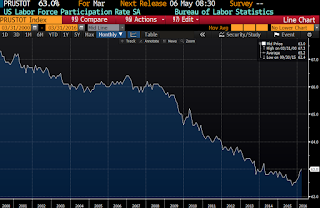| Last | Change | Percent | |
| S&P Futures | 2037.6 | -13.9 | -0.68% |
| Eurostoxx Index | 2920.0 | -85.0 | -2.83% |
| Oil (WTI) | 37.05 | -1.3 | -3.36% |
| LIBOR | 0.625 | -0.006 | -0.91% |
| US Dollar Index (DXY) | 94.63 | 0.048 | 0.05% |
| 10 Year Govt Bond Yield | 1.76% | -0.01% | |
| Current Coupon Ginnie Mae TBA | 105.6 | ||
| Current Coupon Fannie Mae TBA | 104.9 | ||
| BankRate 30 Year Fixed Rate Mortgage | 3.65 |
Stocks are lower after the jobs report. Bonds and MBS are flat.
- Payrolls up 215k vs 205k expected
- Unemployment rate 5% up .1%
- Labor Force Participation rate 63%
- Average hourly earnings up 2.3% YOY
- Average hourly earnings flat at 34.4
Manufacturing employment fell 29k, while restaurant increased 25k, retail, up 48k and construction up 37k. This is the fifth straight increase in the labor force participation rate, which bottomed out (hopefully) in September. The lower the labor force participation rate, the lower the speed limit for the economy. The improvement in the participation rate drove an increase in the unemployment rate, and this is one of those times where an increase in the unemployment rate is actually a good thing because it means that discouraged workers are now beginning to see enough opportunity out there to look for a job. Remember, if you are unemployed and not actively looking for a job, you are not considered to be part of the labor force, and therefore you aren't officially "unemployed" according to the government. Wages rebounded from a negative February. Overall, a decent report - the wage growth will certainly push the Fed to take another step towards normalization of interest rates, and a June hike is looking more certain.
Despite the drop in manufacturing employment, the ISM Manufacturing Index increased smartly in March, New Orders and production drove the increase, while employment fell. Prices rose as commodity and raw material prices increased. This level of manufacturing would be consistent with 2% GDP growth. A shortage of skilled labor continues to be a problem.
Construction spending fell 0.5% in February, while January was revised upward to an increase of 2.1%. Residential construction rose 0.9% and is up 10.5% YOY. We are almost back to the pre-bubble highs.
Consumer Sentiment ticked up in March, according to the University of Michigan to 91.


No comments:
Post a Comment